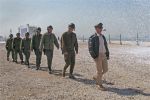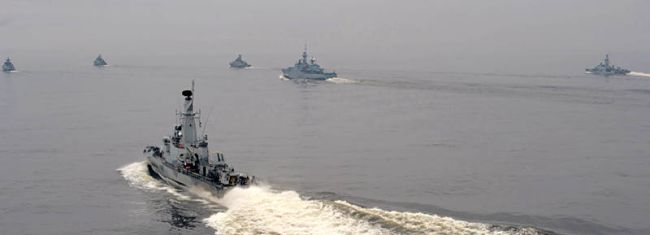SEOUL, South Korea, Sept. 15, 2010 — Inchon, South Korea, took on a movie-set quality today as U.S. Marines and their South Korean and U.N. counterparts re-enacted the massive amphibious landing 60 years ago that ultimately turned the tide in the Korean War.
About 2,500 Korean War veterans, dignitaries and local residents looked on as explosions erupted from the water, “fired” by the USS Dennis, four South Korean and one Australian ship in the waters off Wolmi Island. Amphibious landing craft buzzed the shoreline, helicopters and fighter jets roared overhead, paratroopers dropped from the sky and 167 U.S. Marines from Twentynine Palms, Calif., scaled the seawall and stormed the beach. Just as the action appeared to come to a close, Marine Corps Capt. Michael Borneo thrilled the crowd as he marched across the beach amid a flurry of confetti, costumed as Army Gen. Douglas MacArthur, with fellow Marines depicting his key officers in tow. They demonstrated what Army Gen. Walter L. “Skip” Sharp, commander of United Nations Command, Combined Forces Command and U.S. Forces Korea, called “one of the boldest operations conducted in U.S. military history” “This history-making operation not only helped to turn the tide of the war, but it highlighted the kind of cooperation between our services and between the nations that continue to help keep the Republic of Korea free today,” Sharp told Korean War veterans attending the 60th anniversary commemoration. Navy Adm. Patrick M. Walsh, commander of U.S. Pacific Fleet, praised the “undaunting courage” exhibited during the operation — one that “had been dismissed as not doable” by many due to extreme tide shifts. “It’s humbling,” Walsh said. “We are standing in the shadow of giants.” MacArthur, who had pressed for the surprise attack to take place while the main North Korean fighting force had focused its effort on the southeast, finally overcame those challenging his plan, and “Operation Chromite” was launched Sept. 15, 1950. U.S. and South Korean Marines, along with their counterparts from Australia, Canada, France, the Netherlands, New Zealand and the United Kingdom, launched the landing in three separate locations. Lead elements of 10th Corps hit “Green Beach” on the north side of Wolmi Island. Its landing force consisted of 3rd Battalion, 5th Marines, and nine M26 Pershing tanks from the 1st Tank Battalion. Meanwhile, Combat Team 5, which included 3rd Battalion South Korean Marines, scaled the seawalls along “Red Beach.” After overpowering the North Korean defenses, they opened the causeway that enabled tanks from Green Beach to enter the fight. To the south, the 1st Marine Regiment arrived at “Blue Beach,” where they encountered little resistance because North Korean forces already had surrendered. The successes in Inchon ultimately broke the North Korean army’s supply lines and paved the way to the liberation of Seoul in late September 1950. South Korean Lt. j.g. Junsung Lee called the surprise nature of the attack a key in catching the North Koreans off-guard. “The Inchon landing operation was crucial for us to take back the initiative,” he said. “It was a key event.” William Cheek, a Marine corporal assigned to an anti-tank assault unit during the operation, recalled during today’s ceremonies the challenges he and his fellow Marines encountered. After overcoming 30-foot tides in Inchon Harbor, their amphibious landing vessel Amtrak got stalled in the sand, forcing Cheek to dash about 100 yards across the beach, dodging North Korean tank and infantry fire. Ultimately, they fought their way to Seoul, supported every step of the way by South Korean civilian volunteers. Standing beneath a giant Ferris wheel on the landing beach that’s blossomed as a popular tourist attraction, Cheek said he felt proud to see South Korea become “a modern economic miracle.” “I’m glad some of us were able to help make that possible,” he said, “helping drive out the elements trying to enslave a great nation.” Navy Vice Adm. Scott R. Van Buskirk, who assumed command of the U.S. 7th Fleet in Japan last week, said the Inchon landing provides a classic example of the Navy-Marine “blue-green team” concept. It also underscores the importance of amphibious landing capabilities that remain critical today, he added. Marine Corps 1st Sgt. Alex Leibfried, led 167 members of 1st Battalion, 7th Marines, who stormed the beach during today’s reenactment, and he said it felt good to get the opportunity to demonstrate those capabilities. “It’s probably the No. 1 way we come ashore,” the 18-year veteran said. “It’s good seeing that the Marine Corps is finally getting back to its amphibious roots.”
Source:
U.S. Department of Defense
Office of the Assistant Secretary of Defense (Public Affairs)

 von
von 
